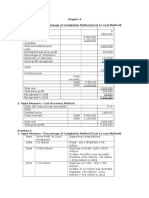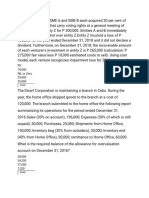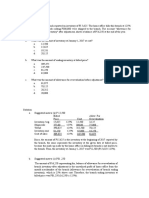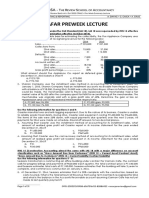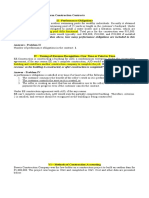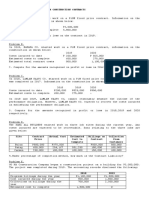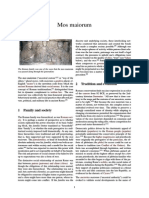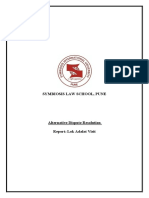0 ratings0% found this document useful (0 votes)
1K viewsAdvacc 1 Quiz VIII
Advacc 1 Quiz VIII
Uploaded by
Jason GubatanThis document contains 17 multiple choice questions regarding accounting for construction contracts using the percentage-of-completion and cost recovery methods. The questions provide partial contract data such as contract price, costs incurred, billings, collections, and estimated costs to complete for various construction companies over multiple years. Respondents are asked to calculate amounts such as gross profit, loss, and construction in progress balances based on the data provided for each question.
Copyright:
© All Rights Reserved
Available Formats
Download as DOCX, PDF, TXT or read online from Scribd
Advacc 1 Quiz VIII
Advacc 1 Quiz VIII
Uploaded by
Jason Gubatan0 ratings0% found this document useful (0 votes)
1K views4 pagesThis document contains 17 multiple choice questions regarding accounting for construction contracts using the percentage-of-completion and cost recovery methods. The questions provide partial contract data such as contract price, costs incurred, billings, collections, and estimated costs to complete for various construction companies over multiple years. Respondents are asked to calculate amounts such as gross profit, loss, and construction in progress balances based on the data provided for each question.
Original Description:
Advacc1 Quiz 8
Copyright
© © All Rights Reserved
Available Formats
DOCX, PDF, TXT or read online from Scribd
Share this document
Did you find this document useful?
Is this content inappropriate?
This document contains 17 multiple choice questions regarding accounting for construction contracts using the percentage-of-completion and cost recovery methods. The questions provide partial contract data such as contract price, costs incurred, billings, collections, and estimated costs to complete for various construction companies over multiple years. Respondents are asked to calculate amounts such as gross profit, loss, and construction in progress balances based on the data provided for each question.
Copyright:
© All Rights Reserved
Available Formats
Download as DOCX, PDF, TXT or read online from Scribd
Download as docx, pdf, or txt
0 ratings0% found this document useful (0 votes)
1K views4 pagesAdvacc 1 Quiz VIII
Advacc 1 Quiz VIII
Uploaded by
Jason GubatanThis document contains 17 multiple choice questions regarding accounting for construction contracts using the percentage-of-completion and cost recovery methods. The questions provide partial contract data such as contract price, costs incurred, billings, collections, and estimated costs to complete for various construction companies over multiple years. Respondents are asked to calculate amounts such as gross profit, loss, and construction in progress balances based on the data provided for each question.
Copyright:
© All Rights Reserved
Available Formats
Download as DOCX, PDF, TXT or read online from Scribd
Download as docx, pdf, or txt
You are on page 1of 4
At a glance
Powered by AI
The key takeaways are that the percentage of completion and cost recovery methods are approaches for recognizing revenue and gross profit over time for long-term construction contracts. The percentage of completion method recognizes revenue and gross profit based on the proportion of costs incurred to date compared to total estimated costs, while the cost recovery method only recognizes revenue up to the amount of costs incurred.
Under the percentage of completion method, revenue and gross profit are recognized over time based on the proportion of costs incurred compared to total estimated costs. Progress billings and collections are recorded, with the difference between billings and recognized revenue reported as an asset or liability. Gross profit is calculated at each reporting date based on the cost and revenue recognized to date.
The percentage of completion method recognizes revenue and gross profit over time based on costs incurred, while the cost recovery method only recognizes revenue up to the amount of costs incurred, with no gross profit recognized until all costs are recovered. The percentage of completion method more accurately matches revenue with the work performed, while the cost recovery method is more conservative.
Quiz VIII
1.Palmer construction company has consistently used the percentage of
completion method of recognizing income. In 20x4 palmer started work on a
P3,000,000 construction contract, which was completed in 20x5. The accounting
records disclosed the following data:
20x4
20x5
Progress billings
1,100,000 1,900,000
Costs incurred
900,000
1,800,000
Collections
700,000
2,300,000
Estimated cost to completed
1,800,000
How much gross profit should Palmer have recognized in 20x4?
2. C&J construction inc has consistently used percentage of completion method
of recognizing income. Last year C&J started work on a P4,500,000 construction
contract, which was completed this year. The accounting records disclosed the
following data for last year:
Progress billings
1,650,000
Costs incurred
1,350,000
Collections
1,050,000
Estimated cost to complete
2,700,000
How much income should C&J have recognized on this contract last year?
3. Shepard construction company uses the percentage of completion method of
accounting. On January 10, 20x5, Shepard began work on a P3,000,000
construction contract. At the inception date, the estimated cost of construction
was P2,250,000. The following data relate to the progress of the contract:
Gross profit recognized at December 31, 20x5
300,000
Costs incurred Jan. 10, 20x5, through Dec. 31, 20x6 1,800,000
Estimated cost to complete at December 31, 20x6 600,000
How much gross profit should Shepard recognized for the year ended December
31, 20x6?
4. Salmon construction company uses the percentage of completion method of
accounting. In 20x5, salmon began work on a project which had a contract price
of 1,600,000 and estimated costs of 1,200,000. Additional information is as
follows:
20x5
20x6
Cost incurred during the year
240,000
1,060,000
Estimated costs to complete as of 12/31/20x5
960,000
Billings during the year
290,000
1,310,000
Collections during the year
250,000
1,200,000
The amount of gross profit Salmon should recognize on this contract during 20x5
is
5. Brown construction company uses the percentage of completion method for
long term construction contracts. A specific job was begun in 20x5 and
completed in 20x7. The contract price was 1,400,000 and cost information as of
each year-end is given below:
20x5
20x6
20x7
End of year estimated cost to complete
400,000
200,000
0
Annual cost incurred
400,000
400,000
120,000
Assuming Brown correctly recorded gross profit in 20x5, how much gross profit
should the company record in 20x6?
6. The following data relate to a construction job started by Worthington co.
during 20x5:
Total contract price
300,000
Actual costs incurred during 20x5
60,000
Estimated remaining cost
120,000
Billed to customer during 20x5
90,000
Received from customer during 20x6
30,000
Under the cost recovery method, how much should Worthington recognize as
gross profit for 20x5?
7. In early 20x5, the Miami company signed a contract for construction of an
industrial park to be completed in three years. At the time, estimated total cost
were P2,250,000. And estimated total revenues were 4,000,000. During 20x5,
Miami incurred cost of P960,000 and collected P1,100,000. In December 20x5,
Miami recalculated total costs for the project to be P3,200,000 while estimated
total revenues remained unchanged. What amount of profit(loss) should be
recognized by Miami for 20x5, using the percentage of completion method?
8. In 20x5, Alpha construction began work on a contract with a price of P850,000
and estimated cost of P595,000. Data for each year of the contract are as
follows:
20x5
20x6
20x7
Costs incurred during the year
238,000
319,600
105,000
Estimated costs to complete
357,000
139,400
0
Partial billings
260,000
210,000
380,000
Collections
240,000
200,000
410,000
Under the percentage of completion method of revenue recognition, gross profit
in 20x5 would be
9. On May 1, 20x5 Green construction company entered into a fixed-price
contract to construct an apartment building for P3,000,000. Green appropriately
accounts for this contract under the percentage of completion method.
Information relating to the contract is as follows:
20x5
20x6
At December 31:
Percentage of completion
20%
60%
Estimated costs at completion
2,250,000
2,400,000
Income recognized(cumulative)
150,000
360,000
What is the amount of contract costs incurred during the year ended December
31, 20x6?
10. Jessup construction inc. has consistently used the percentage of completion
method of recognizing income. During 20x5 Jessup started work on a P1,500,000
fixed-price construction contract. The accounting records disclosed the following
data for the year ended December 31, 20x5:
Costs incurred
465,000
Estimated cost to complete
1,085,000
Progress billings
550,000
Collections
350,000
How much loss should Jessup have recognized in 20x5?
11. During 20x5 Gates corp. started a construction job with a total contract price
of P3,500,000. The job was completed on December 15, 20x6. Additional data
are as follows:
20x5
20x6
Actual costs incurred
1,350,000
1,525,000
Estimated remaining costs
1,350,000 --Billed to customer
1,200,000 2,300,000
Received from customer
1,000,000 2,400,000
Under the cost recovery method, what amount should Gates recognize as gross
profit for 20x6?
12. Rainbow construction company uses the percentage of completion method
for long-term construction contracts. The company started a project with a
contract price of P2,750 in 20x5. Given the following data, what is the balance in
Construction in Progress for this contract at the end of 20x5?
20x5
20x6
Costs incurred this year
400
500
Total estimated costs remaining at the end of the year
1,600
1,000
13. Lake construction company uses the cost recovery method for long term
construction contracts. The information for a specific contract as of January 1,
20x5 is shown below:
Costs incurred to date
700,000
Contract price
2,000,000
Estimated remaining cost to complete
800,000
P600,000 of cost was incurred during 20x5 and on December 31, 20x5, the
estimated remaining cost to complete was still P800,000. The correct balance for
the construction in progress at December 31, 20x5 is
14. In 20x5, Aldaus corp. began construction work under a three-year contract.
The contract price is P800,000. Aldaus used the percentage of completion
method for financial accounting purposes. The income to be recognized each
year is based on the proportion of cost incurred to total estimated costs for
completing the contract. The financial presentation relating to this contract at
December 31, 20x5 appear below.
Balance Sheet
Accounts receivable construction contract billings
Construction is progress
50,000
Less contract billings
(47,000)
Cost of uncompleted contract in excess of billings
Income Statement
15,000
3,000
Income (before tax) on the contract recognized in year 1.
How much cash was collected in 20x5 on this contract?
10,000
15. In 20x5, Alpha construction began work on a contract with a price of
P850,000 and estimated cost of P595,000. Data for each year of the contract are
as follows:
20x5
20x6
20x7
Costs incurred during the year
238,000
319,600
105,000
Estimated costs to complete
357,000
139,400
0
Partial billings
260,000
210,000
380,000
Collections
240,000
200,000
410,000
Under the percentage of completion method of revenue recognition, the balance
in construction in progress at the end of 20x6 would be?
16. In 20x5, Alpha construction began work on a contract with a price of
P850,000 and estimated cost of P595,000. Data for each year of the contract are
as follows:
20x5
20x6
20x7
Costs incurred during the year
238,000
319,600
105,000
Estimated costs to complete
357,000
139,400
0
Partial billings
260,000
210,000
380,000
Collections
240,000
200,000
410,000
Under the percentage of completion method of revenue recognition, the net
amount reported for construction in progress inventory at the end of 20x6 would
be
17. In 20x5, Alpha construction began work on a contract with a price of
P850,000 and estimated cost of P595,000. Data for each year of the contract are
as follows:
20x5
20x6
20x7
Costs incurred during the year
238,000
319,600
105,000
Estimated costs to complete
357,000
139,400
0
Partial billings
260,000
210,000
380,000
Collections
240,000
200,000
410,000
Under the percentage of completion method of revenue recognition, the net
amount reported for construction in progress inventory at the end of 20x6 would
be
You might also like
- PQ2Document2 pagesPQ2alellieNo ratings yet
- Advanced AccountingDocument8 pagesAdvanced AccountingCindy Pausanos Paradela0% (1)
- Afar 4Document1 pageAfar 4Bonna Kerstine TiburcioNo ratings yet
- PROBLEMSDocument19 pagesPROBLEMSlalalalaNo ratings yet
- Test Bank Paccounting Information Systems Test Bank Paccounting Information SystemsDocument23 pagesTest Bank Paccounting Information Systems Test Bank Paccounting Information SystemsFrylle Kanz Harani PocsonNo ratings yet
- 03 SJS Officers v. LimDocument2 pages03 SJS Officers v. LimMigs Raymundo100% (1)
- Revenue Recognition: Long Term ConstructionDocument3 pagesRevenue Recognition: Long Term ConstructionLee SuarezNo ratings yet
- Special Revenue Recognition Special Revenue RecognitionDocument4 pagesSpecial Revenue Recognition Special Revenue RecognitionCee Gee BeeNo ratings yet
- Construction ContractsDocument2 pagesConstruction ContractsLordson Ramos50% (2)
- AA2Q1Document1 pageAA2Q1Sweet EmmeNo ratings yet
- NFJPIA Mockboard 2011 P2Document6 pagesNFJPIA Mockboard 2011 P2ELAIZA BASHNo ratings yet
- Buscom Quiz 2 MidtermDocument2 pagesBuscom Quiz 2 MidtermRafael Capunpon VallejosNo ratings yet
- Problem 11 AFARDocument4 pagesProblem 11 AFARNorman Delirio0% (1)
- Chapter 8Document7 pagesChapter 8Yenelyn Apistar CambarijanNo ratings yet
- AFAR PracDocument13 pagesAFAR PracTeofel John Alvizo PantaleonNo ratings yet
- Practical Accounting 2Document4 pagesPractical Accounting 2Steph BorinagaNo ratings yet
- Aud Theo Part 2Document10 pagesAud Theo Part 2Naia Gonzales0% (2)
- Advanced Accounting Part 1 Dayag 2015 Chapter 6Document19 pagesAdvanced Accounting Part 1 Dayag 2015 Chapter 6trisha sacramentoNo ratings yet
- DocDocument5 pagesDocYour Materials33% (3)
- Instruction: Show Your Solution. No Solution Incorrect AnswerDocument1 pageInstruction: Show Your Solution. No Solution Incorrect AnswerRian ChiseiNo ratings yet
- Home and Branch Part 1Document4 pagesHome and Branch Part 1Jessica Libunao100% (1)
- Activity - Chapter 4Document2 pagesActivity - Chapter 4Greta DuqueNo ratings yet
- Csa 10Document2 pagesCsa 10Von Andrei MedinaNo ratings yet
- Practical Accounting 2Document4 pagesPractical Accounting 2RajkumariNo ratings yet
- ULOd ANSWER KEYDocument2 pagesULOd ANSWER KEYzee abadillaNo ratings yet
- Accounting For Special Transactions and Cost Accounting and ControlDocument12 pagesAccounting For Special Transactions and Cost Accounting and ControlRNo ratings yet
- QZ CHPT 13 9 10 Answers OnlyDocument6 pagesQZ CHPT 13 9 10 Answers OnlyKim TranNo ratings yet
- Branches and Agencies - OdtDocument9 pagesBranches and Agencies - OdtEunice BernalNo ratings yet
- A. Technical MalversationDocument8 pagesA. Technical MalversationDinosaur Korean100% (1)
- Apllied Auditing Q&ADocument10 pagesApllied Auditing Q&APeterJorgeVillarante100% (2)
- Cpar - P2 09.15.13Document22 pagesCpar - P2 09.15.13Leo Mark Ramos100% (1)
- Competency Appraisal UM Digos (PARTNERSHIP)Document10 pagesCompetency Appraisal UM Digos (PARTNERSHIP)Diana Faye CaduadaNo ratings yet
- This Study Resource Was: Consignment SalesDocument3 pagesThis Study Resource Was: Consignment SalesKez MaxNo ratings yet
- Busicom Prob 6-8Document7 pagesBusicom Prob 6-8JrllsyNo ratings yet
- 8506 - Installment SalesDocument4 pages8506 - Installment SalesAnonymous iNRMC4mgORNo ratings yet
- Correction of Errors: Identify The Letter of The Choice That Best Completes The Statement or Answers The QuestionDocument5 pagesCorrection of Errors: Identify The Letter of The Choice That Best Completes The Statement or Answers The QuestionmaurNo ratings yet
- 1st Acctg8Document4 pages1st Acctg8John Bryan100% (1)
- Acc 310 - M004Document12 pagesAcc 310 - M004Edward Glenn BaguiNo ratings yet
- CEL 1 PRAC 1 Answer KeyDocument12 pagesCEL 1 PRAC 1 Answer KeyRichel ArmayanNo ratings yet
- Advanced AccountingDocument6 pagesAdvanced AccountingMarisa CaraganNo ratings yet
- ASCA301 Module 1 DiscussionDocument22 pagesASCA301 Module 1 DiscussionKaleu MellaNo ratings yet
- A Home Office InventoryDocument1 pageA Home Office InventoryJulrick Cubio EgbusNo ratings yet
- Long Quiz 2Document8 pagesLong Quiz 2CattleyaNo ratings yet
- Afar 2Document7 pagesAfar 2Diana Faye CaduadaNo ratings yet
- ADVACCDocument6 pagesADVACCangela arcedoNo ratings yet
- CH 05Document25 pagesCH 05Ahmed Al EkamNo ratings yet
- Activity For Finals TermDocument6 pagesActivity For Finals TermRhegee Irene RosarioNo ratings yet
- Quiz Recl FinancingDocument1 pageQuiz Recl FinancingLou Brad IgnacioNo ratings yet
- Consolidated Net IncomeDocument1 pageConsolidated Net IncomePJ PoliranNo ratings yet
- LiabilitiesDocument2 pagesLiabilitiesFrederick AbellaNo ratings yet
- AuditingDocument4 pagesAuditingMaria Carmela MoraudaNo ratings yet
- Chapter 10Document9 pagesChapter 10chan.charanchan100% (1)
- AFAR Preweek (B44) - HIGHLIGHTEDDocument31 pagesAFAR Preweek (B44) - HIGHLIGHTEDMARIA VERNADETTE SHARISSE LEGASPINo ratings yet
- AFAR Preweek (B46)Document30 pagesAFAR Preweek (B46)cjpentinioNo ratings yet
- Resa Afar (1) Preweek (b43)Document34 pagesResa Afar (1) Preweek (b43)MellaniNo ratings yet
- Multiple Choice Problems 21 Lark Corp. Has Contract To Construct A P5,000,000 Cruise Ship at An Estimated Cost ofDocument12 pagesMultiple Choice Problems 21 Lark Corp. Has Contract To Construct A P5,000,000 Cruise Ship at An Estimated Cost ofRie Cabigon100% (1)
- Installment and LTCCDocument9 pagesInstallment and LTCCAngelica RubiosNo ratings yet
- Exam Integ ExamDocument10 pagesExam Integ ExamRisalyn BiongNo ratings yet
- CH 10 Long Term ContractsDocument6 pagesCH 10 Long Term ContractsMerr Fe PainaganNo ratings yet
- Percentage of Completion 33.33%Document6 pagesPercentage of Completion 33.33%AlexNo ratings yet
- Practice Set # 7B: Long-Term Construction ContractsDocument2 pagesPractice Set # 7B: Long-Term Construction ContractsRey Joyce AbuelNo ratings yet
- SSRN Id2154881Document16 pagesSSRN Id2154881Manish GaikwadNo ratings yet
- Mos MaiorumDocument4 pagesMos MaiorumValentin MateiNo ratings yet
- SCIR Spring 2019 EditionDocument95 pagesSCIR Spring 2019 EditionSC International Review100% (1)
- The Indian Removal ActDocument4 pagesThe Indian Removal ActMariokibmib50% (2)
- 138 Pardo v. Hercules Lumber Co. and Ferrer (Castro)Document1 page138 Pardo v. Hercules Lumber Co. and Ferrer (Castro)AlexandraSoledadNo ratings yet
- Shihabudheen Doh CCJDocument2 pagesShihabudheen Doh CCJShihab AkNo ratings yet
- Module II Lesson 2 3Document11 pagesModule II Lesson 2 3mongskiekangtimNo ratings yet
- SOLITARY CONFINEMENT IpcDocument7 pagesSOLITARY CONFINEMENT IpcBenazir KadriNo ratings yet
- Joint - Solidary - Divisible IndivisibleDocument4 pagesJoint - Solidary - Divisible IndivisibleVanessa Evans CruzNo ratings yet
- JVD 6 Step Verification FormDocument2 pagesJVD 6 Step Verification FormVasavi Computers100% (6)
- Spouses Jesus G. Crisologo and Nannette B. Crisologo, V Judge George E. OmelioDocument2 pagesSpouses Jesus G. Crisologo and Nannette B. Crisologo, V Judge George E. OmelioJustin Niel VillanuevaNo ratings yet
- Solutions Gold Adv Short Test U8 Test 1ADocument2 pagesSolutions Gold Adv Short Test U8 Test 1AWiktoria HebaNo ratings yet
- ADR Lok AdalatDocument8 pagesADR Lok AdalatAditi KulshreshthaNo ratings yet
- Ilovepdf MergedDocument18 pagesIlovepdf MergedIzza Marie D. PAGUNTALANNo ratings yet
- First Law CommissionDocument2 pagesFirst Law Commissionrishirawatfreefire2No ratings yet
- Media and Contempt of Court - HiyaDocument14 pagesMedia and Contempt of Court - HiyaHiya BhattacharyaNo ratings yet
- Annexure 8 - Model Draft Agreement With Business Correspondent-Revised 05.06.2024Document15 pagesAnnexure 8 - Model Draft Agreement With Business Correspondent-Revised 05.06.2024Abhinay HingeNo ratings yet
- Evidence by Atty Jay MazoDocument183 pagesEvidence by Atty Jay MazoJed DizonNo ratings yet
- TM-1202 AVEVA Plant 12.1 Piping Catalogues & Specifications 2.0Document254 pagesTM-1202 AVEVA Plant 12.1 Piping Catalogues & Specifications 2.0Alessio AgnettiNo ratings yet
- Job - RFP No. VIII-2023-5909 - Rent A Car Per Day - Re-BiddingDocument3 pagesJob - RFP No. VIII-2023-5909 - Rent A Car Per Day - Re-BiddingNayabNo ratings yet
- 246C3BDocument3 pages246C3BBabuNo ratings yet
- Case Study 4 - Pros & Cons of Doctrinal Legal ResearchDocument3 pagesCase Study 4 - Pros & Cons of Doctrinal Legal ResearchSushmaNo ratings yet
- 1 Syllabus Perpajakan 2 Gasal 2020 - 21 DDocument8 pages1 Syllabus Perpajakan 2 Gasal 2020 - 21 DauliaNo ratings yet
- Competition ActDocument23 pagesCompetition ActPurushottam KumarNo ratings yet
- Moot Court Respondent 7-10Document40 pagesMoot Court Respondent 7-10sonobarshafi0No ratings yet
- Subject:Legal Ethics and Court CraftDocument8 pagesSubject:Legal Ethics and Court CraftNiraj PandeyNo ratings yet
- Subpart Q Flight and Duty Time Limitations and Rest RequirementsDocument14 pagesSubpart Q Flight and Duty Time Limitations and Rest RequirementscplowhangNo ratings yet
- G.R. No. 197494Document5 pagesG.R. No. 197494Sheraina GonzalesNo ratings yet
- SSRN Id2014351Document19 pagesSSRN Id2014351SrivastavaNo ratings yet

















